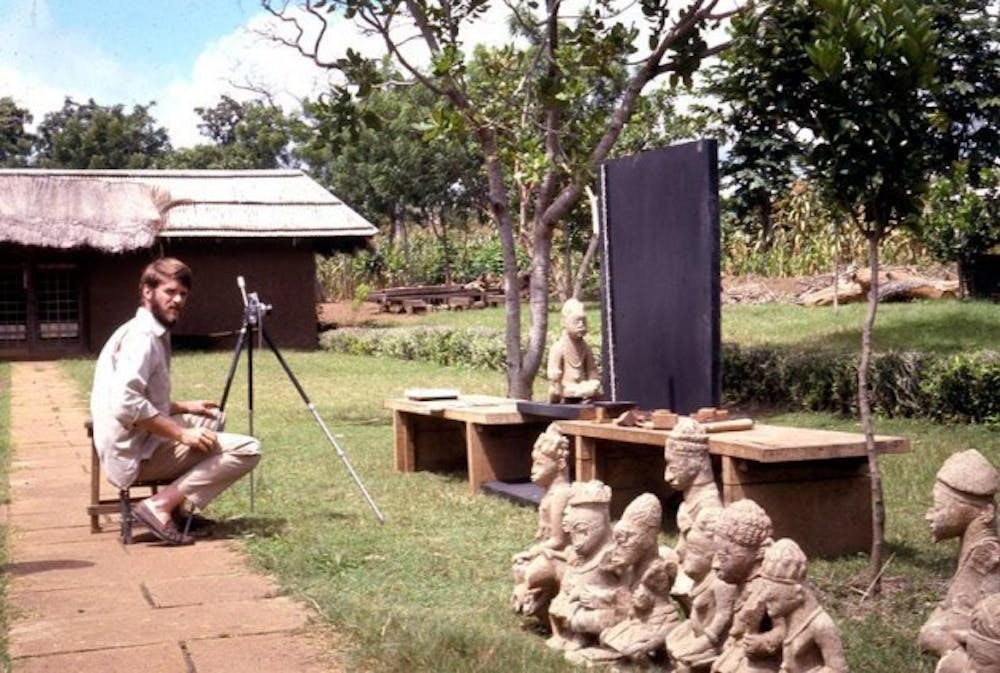Phillips Stevens Jr. is heading to Nigeria next month and is coming back to UB with a new title: chief.
Stevens, an associate professor of anthropology, is going to Nigeria on Nov. 29 to celebrate the 25th anniversary of the leader of the Esie people. As a part of this celebration, the Esie people are honoring Stevens for his contributions in preserving the village's cultural artifacts. Stevens has been involved with the tribe since the 1960s; he first visited as a member of the Peace Corps.
"I will be meeting with the grandchildren of the people I originally worked with," Stevens said. "They still talk about when I was there; they remember."
Stevens recognizes the irregularity of a Westerner receiving such an honor.
The Elesie, the ruler of the tribe, will be granting the honorary chieftaincy during a three-day celebration, where Stevens will be garbed in a set of ceremonial robes and crowned with a garland of leaves. Stevens will be named Erewumi, which means "I get along well with the images" - a nickname the villagers gave to him when he first visited nearly 50 years ago when he took numerous pictures of the statues.
He credits his rapport with the Esie to the fact that he didn't isolate himself from the villagers while working in the Peace Corps.
"The people weren't expecting us to cut our own grass, to tend our own garden," Stevens said. "We were Westerners with college degrees. But we were from the Peace Corps. We weren't their superiors. We were there to help them."
Now Stevens will be returning to receive the honorific and to tour the museum he helped build which still houses the statues he helped save.
Stevens' colleagues know him as a modest man of integrity who has impeccable manners - a man who quietly teaches and writes, not a man who seeks accolades and limelight.
"As a person Phil is decent, caring and cordial," said Howard Wolf, an emeritus professor in the English department, who also taught in Africa in 1998. "As a teacher he is serious, committed to his discipline, interested in his students' development and fair. As a scholar he has made important contributions to his field through his research in Nigeria."
His students agree.
While offering her congratulations, Jessica Fletcher, a senior anthropology major, noted Stevens for his commitment to his students.
"He really does care about the success of his students," Fletcher said. "He has always helped to provide opportunities for them to excel in their chosen fields. He's also always been there to help his students in what comes next after graduation, whether it's grad school or establishing a career in anthropology."
Stevens has been known to offer up his experience as a mentor to members of UB's anthropology club and to speak at campus events about how his time in the Peace Corps changed the trajectory of his career.
Stevens obtained his undergraduate degree in English from Yale. He then joined the Peace Corps and began teaching English in Nigeria in 1963. However, during the school's recess, he worked for the Federal Ministry of Education's Department of Antiquities; that is when Stevens was asked to photograph and catalog the statues he is now being honored for saving. The collection of ancient soapstone statuary was discovered on the outskirts of the village in the 1930s by the British colonial government.
The statues, which range in size from a few inches to several feet, depict men and women armed for war or laughing and frolicking. They are overseen by a king statue, which is crusted over with dried blood - the remains of decades' worth of sacrificial offerings.
Additionally, Stevens was asked to repair as many pieces as possible. Eventually, he was put in charge of overseeing the construction of a new museum complex to permanently house the statues.
Stevens doesn't remember being nervous about attempting the repairs without any formal anthropological or art restoration experience.
"I just remember it was an important job," he said. "I was young, optimistic and idealistic then."
Stevens experimented using resin and crushed fragments of soapstone for pigmentation to match the statues' natural colors. He eventually found the right combination and repaired the statues using a compound donated by a Swiss chemical company. The repair materials were stronger than the statues, so Stevens had to be careful not to damage the statues again.
He went back to Esie in 1974 to take more photos and to conduct a cultural and geological investigation regarding the statues' origins.
According to the Esie people, the figures are the petrified remains of otherworldly visitors. From his research, Stevens was able to conclude that the soapstone used for the statuary was not native to the area.
Stevens believes that the statues may have been left by a migrating group that intended to return to the area but didn't.
"The statues are very heavy," Stevens said. "Litters would have been necessary to move them. This indicates that the group members planned to return. But that period was a time of rapid migration, and the trans-Atlantic slave trade. Something might have prevented their return." Whatever the statues' origins, the Esie people acknowledge they were not made by the tribe. Instead, the people believe it is their fault the visitors were turned to stone, and so the statues are revered. They have occupied a place in the Esie cosmology since the mid-19th century and, until recently, were reverenced by a cult with an established priesthood.
Stevens wrote the 1978 book, The Stone Images of Esie,Nigeria, in connection with the Second World African Festival of Arts and Culture, because of his work with the statues.
More recently, he edited a four-volume work on the anthropology of religion, published by Routledge. Next year, three of his articles will be published as part of the "Encyclopedia of Sexuality."
He is currently preparing work on the subject of magic and witchcraft in anthropology.
Email: news@ubspectrum.com





